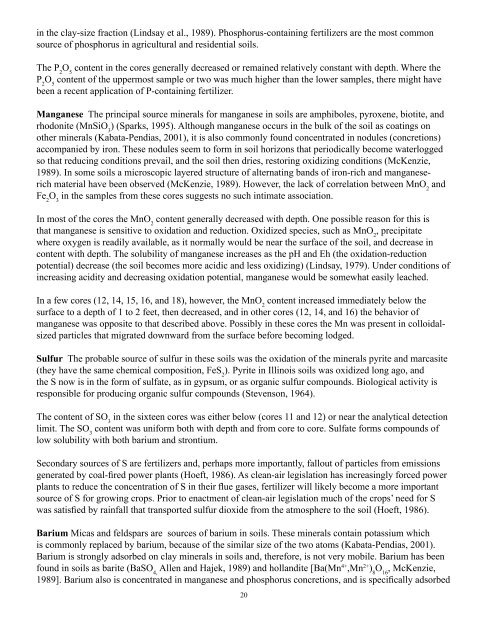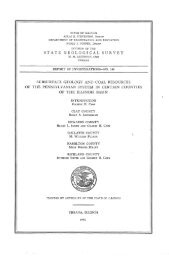Cores 11 through 26 by Gary B. Dr - University of Illinois at Urbana ...
Cores 11 through 26 by Gary B. Dr - University of Illinois at Urbana ...
Cores 11 through 26 by Gary B. Dr - University of Illinois at Urbana ...
Create successful ePaper yourself
Turn your PDF publications into a flip-book with our unique Google optimized e-Paper software.
in the clay-size fraction (Lindsay et al., 1989). Phosphorus-containing fertilizers are the most commonsource <strong>of</strong> phosphorus in agricultural and residential soils.The P 2O 5content in the cores generally decreased or remained rel<strong>at</strong>ively constant with depth. Where theP 2O 5content <strong>of</strong> the uppermost sample or two was much higher than the lower samples, there might havebeen a recent applic<strong>at</strong>ion <strong>of</strong> P-containing fertilizer.Manganese The principal source minerals for manganese in soils are amphiboles, pyroxene, biotite, andrhodonite (MnSiO 3) (Sparks, 1995). Although manganese occurs in the bulk <strong>of</strong> the soil as co<strong>at</strong>ings onother minerals (Kab<strong>at</strong>a-Pendias, 2001), it is also commonly found concentr<strong>at</strong>ed in nodules (concretions)accompanied <strong>by</strong> iron. These nodules seem to form in soil horizons th<strong>at</strong> periodically become w<strong>at</strong>erloggedso th<strong>at</strong> reducing conditions prevail, and the soil then dries, restoring oxidizing conditions (McKenzie,1989). In some soils a microscopic layered structure <strong>of</strong> altern<strong>at</strong>ing bands <strong>of</strong> iron-rich and manganeserichm<strong>at</strong>erial have been observed (McKenzie, 1989). However, the lack <strong>of</strong> correl<strong>at</strong>ion between MnO 2andFe 2O 3in the samples from these cores suggests no such intim<strong>at</strong>e associ<strong>at</strong>ion.In most <strong>of</strong> the cores the MnO 2content generally decreased with depth. One possible reason for this isth<strong>at</strong> manganese is sensitive to oxid<strong>at</strong>ion and reduction. Oxidized species, such as MnO 2, precipit<strong>at</strong>ewhere oxygen is readily available, as it normally would be near the surface <strong>of</strong> the soil, and decrease incontent with depth. The solubility <strong>of</strong> manganese increases as the pH and Eh (the oxid<strong>at</strong>ion-reductionpotential) decrease (the soil becomes more acidic and less oxidizing) (Lindsay, 1979). Under conditions <strong>of</strong>increasing acidity and decreasing oxid<strong>at</strong>ion potential, manganese would be somewh<strong>at</strong> easily leached.In a few cores (12, 14, 15, 16, and 18), however, the MnO 2content increased immedi<strong>at</strong>ely below thesurface to a depth <strong>of</strong> 1 to 2 feet, then decreased, and in other cores (12, 14, and 16) the behavior <strong>of</strong>manganese was opposite to th<strong>at</strong> described above. Possibly in these cores the Mn was present in colloidalsizedparticles th<strong>at</strong> migr<strong>at</strong>ed downward from the surface before becoming lodged.Sulfur The probable source <strong>of</strong> sulfur in these soils was the oxid<strong>at</strong>ion <strong>of</strong> the minerals pyrite and marcasite(they have the same chemical composition, FeS 2). Pyrite in <strong>Illinois</strong> soils was oxidized long ago, andthe S now is in the form <strong>of</strong> sulf<strong>at</strong>e, as in gypsum, or as organic sulfur compounds. Biological activity isresponsible for producing organic sulfur compounds (Stevenson, 1964).The content <strong>of</strong> SO 3in the sixteen cores was either below (cores <strong>11</strong> and 12) or near the analytical detectionlimit. The SO 3content was uniform both with depth and from core to core. Sulf<strong>at</strong>e forms compounds <strong>of</strong>low solubility with both barium and strontium.Secondary sources <strong>of</strong> S are fertilizers and, perhaps more importantly, fallout <strong>of</strong> particles from emissionsgener<strong>at</strong>ed <strong>by</strong> coal-fired power plants (Hoeft, 1986). As clean-air legisl<strong>at</strong>ion has increasingly forced powerplants to reduce the concentr<strong>at</strong>ion <strong>of</strong> S in their flue gases, fertilizer will likely become a more importantsource <strong>of</strong> S for growing crops. Prior to enactment <strong>of</strong> clean-air legisl<strong>at</strong>ion much <strong>of</strong> the crops’ need for Swas s<strong>at</strong>isfied <strong>by</strong> rainfall th<strong>at</strong> transported sulfur dioxide from the <strong>at</strong>mosphere to the soil (Hoeft, 1986).Barium Micas and feldspars are sources <strong>of</strong> barium in soils. These minerals contain potassium whichis commonly replaced <strong>by</strong> barium, because <strong>of</strong> the similar size <strong>of</strong> the two <strong>at</strong>oms (Kab<strong>at</strong>a-Pendias, 2001).Barium is strongly adsorbed on clay minerals in soils and, therefore, is not very mobile. Barium has beenfound in soils as barite (BaSO 4,Allen and Hajek, 1989) and hollandite [Ba(Mn 4+ ,Mn 2+ ) 8O 16, McKenzie,1989]. Barium also is concentr<strong>at</strong>ed in manganese and phosphorus concretions, and is specifically adsorbed20
















